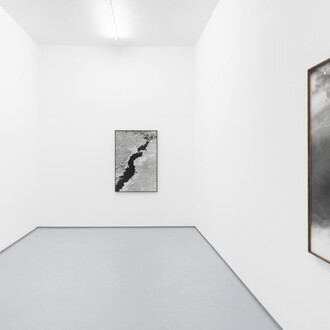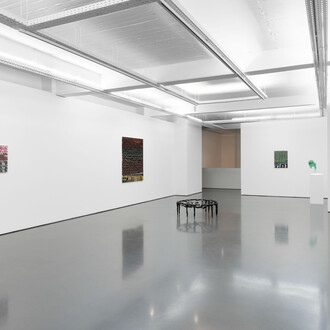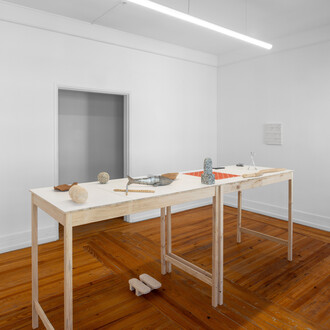“Ex terra factum” (made of earth) is the Latin etymology invented by Alberto Savinio, with his ability of rapid transfiguration of verbal into visual language, of the Italian word “esterrefatto” (astonished, astounded). The definition appears in an early writing, entitled Psicologia dello stupore (Psychology of astonishment), in which the author states: “expressively the language gives the idea of amazement through images of man reduced to matter: being turned to stone, made of earth, etc.” This macaronic etymology does not refer only to the sudden metamorphosis provoked in the observer by the astonishment aroused when looking at particular phenomenal reality, it rather suggests the participatory nature of the relationship of man with the matter of the physical world. A world that, even if inorganic, is never inanimate and inert, but “phantasmic”, namely lit by a sense of enigma crawling under the surface of things, letting perceive a feeling of their entire vitality: the air full of presences, the landscape filled with legends, sedimented underground, the objects whispering to each other, even the statues preserve the lively colour of the skin under the marble’s whiteness.
According to Savinio, the authentic artist has to auscultate this profound reality, tune in with it, take part in it, without transcending it in the name of an ideal, since the content of everyday life is already inexhaustible. “Art requires ‘permanence on earth’. A serious artist, worthy of this name, does not trespass the earth, does not evade nor emigrate from it, but on the earth, in earthly things at hand, mystery and lyricism, amazement and depth have to be found”.
Enzo Cucchi’s work arises from astonishment, an urge imposed by a dazzling image that does not pre-exist the painting, but is consubstantial to it: painting gives shape to a vision blossomed from the surrounding reality, which is the result of a complex perception, not relying exclusively on sight, but caught through sensible organs that act in the artist like the antenna in an insect, or the tail in a dog or a cat. Cucchi’s visual inventory is nurtured by the geography of central Italy: the landscape of Marche, his native region, with the Adriatic sea on one side and the agricultural, hilly countryside on the other, in which spirituality and magic, linked to the peasants culture, persist latent. Another essential source of images is Rome, where the artist has been living since the end of the Seventies, alternating his stays in the Marche region; Rome, the palimpsest city, where the sound of footsteps echoes the ancient time, with its myths and sacred legends lying under the asphalt.
It is not only Cucchi’s iconography to be rooted in the earth: the loose sign and pictorial matter derive from its energy, as well as the gesture that shapes and scratches the sculpture in ceramic or bronze. It is no coincidence that one of Cucchi’s favourite artists of the past is Masaccio, for his realism, his extraordinary feeling of the universe, translated into a work based on a handful of simple ideas, such as “the idea of putting a man in a standing position on the ground, which is what I do when I wake up in the morning – I mean I put my feet on the ground”.
Although figurative, Cucchi’s work adheres to things without ever becoming narrative. Similarly to poetry, it conveys to the observer the perceptive excitement of the artist, recreated on the canvas by the spark produced by the impact of discrete elements, detached from the background continuum, generating visual suspensions loaded with tensions. It is the transposition into painting of an experience lived by the artist himself, enigmas and tensions perceived as elements of alteration and resistance to the flow of reality, which exerted an enthralling fascination, well expressed in one of his verses: “There are many spirits in the air and many shadows on things, it is art that summons and beckons”.
In Daniel Arasse’s study on the detail in painting, it is defined as a particular portion of painting, identified within larger compositions, that catches one’s attention, beckons the observer to look at it with a different gaze. Autonomous with respect to the whole painting, this kind of details sometimes seems to belong to an era different from that of their author, acquiring a universal character, inviting to a close and intimate perception. The “revealing” detail acts as an interruption, an element of emotional intensification that produces a tension with the whole composition, a gap that leads to the breakdown of the narration, to disrupt the device of representation.
The body of small-sized works created by Cucchi in 2017-18 is characterised by the intrinsic power of the “revealing” detail described by Arasse: emotionally intense, the small canvases are autonomous, yet they may have been cut out of a larger composition (“detail” implies a cut, also etymologically). The three paintings from this recent production exhibited at Madragoa show body parts that one is uncertain whether they are human or statues, framed by a close-up view that contains the image in a suspended, ambiguous dimension, as if placed between brackets. In each painting, the body is associated with an apparently unrelated element, a juxtaposition that transposes an epiphany, a microcosm formed by the encounter of elements from different semantic contexts, but also of pictorial and extra-pictorial matter. Osservo (I observe) presents a fragment of what, at first glance, appears to be the scene of a deposition: two legs and a hand with the stigmata, on which the image of a blue bird, standing out on the pale body, is superimposed. The body is rendered with a metallic grey that emphasizes its sculptural hardness, although the muscular tension running through the legs contrasts with the inert pose of the supposed deposition, and their crossed position, on closer inspection, turns out to be impossible. The veneer that cuts the painting on the left side encourages an intimate vision, as if through a window pane, establishing a bridge between the actual reality and the painted surface. Its presence alludes to a piece of frame, underlining its partial dimension. The veneer also appears in Sospeso (Suspended), in which two specular legs reflect a series of contrasts: black and white, empty and full, light and shadow, front and back, while the two doves tied to the calf, like two harmless weapons, ironically evoke the figure of Mercury at rest. The third painting, Untitled, frames the basin of a seemingly classical sculpture, shaded with violet, in whose mutilated part a small skull nestles. The extra-pictorial element consists of a white canvas cut-out overlaid on the raw canvas of the painting’s background. It is another tangible protrusion in the actual world, which in this case evokes a drapery, perhaps hung on the painting by its own naked protagonist.
With Untitled (2018), the sculpture itself is directly projected into the real world, transforming the entire gallery into its own pedestal. Sticking out in the air, the sculpture materialises an epiphany, the appearance of a cloaked figure, with folded hands, that one immediately recognizes as the characteristic and religious image of the Virgin. And yet, even this familiar figure is transformed by Cucchi into an ambiguous and estranging image, by superimposing on the features with which the Virgin is traditionally depicted the image of a cat. With this metamorphosis, the artist trips a popular and reassuring iconography, which is put on hold, suspended, not only in a metaphorical sense. The sculpture’s references can be found in the hybrids of man and animal imagined by the visionary medieval fantasy, and it recalls some figures depicted on bronze bells produced in northern Italy in the fourteenth century. Cast in bronze and coated with a clay patina, the sculpture seems to be made of earth. Extended horizontally in the air, the sky is in the background, its shadow projected on the ground. From above it beckons the passer-by, leaving them astonished.
















